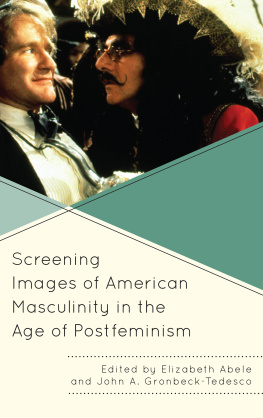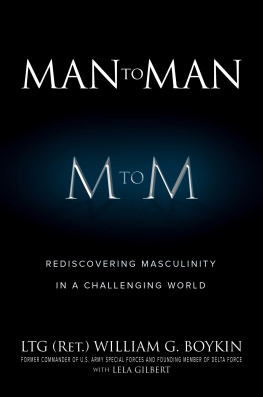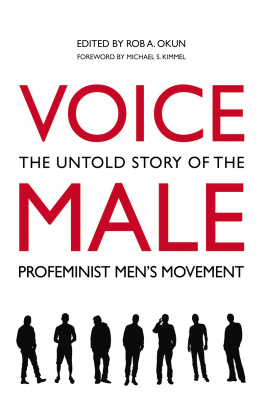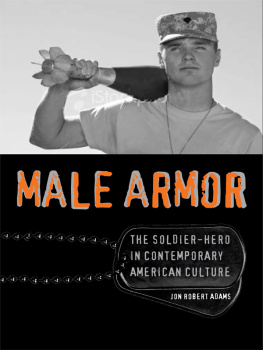Screening Images of American Masculinity in the Age of Postfeminism
Screening Images of American Masculinity in the Age of Postfeminism
Edited by Elizabeth Abele and John A. Gronbeck-Tedesco
lexington Books
Lanham Boulder New York London
Published by Lexington Books
A wholly owned subsidiary of The Rowman & Littlefield Publishing Group, Inc.
4501 Forbes Boulevard, Suite 200, Lanham, Maryland 20706
www.rowman.com
Unit A, Whitacre Mews, 26-34 Stannary Street, London SE11 4AB
Copyright 2016 by Lexington Books
All rights reserved. No part of this book may be reproduced in any form or by any electronic or mechanical means, including information storage and retrieval systems, without written permission from the publisher, except by a reviewer who may quote passages in a review.
British Library Cataloguing in Publication Information Available
Library of Congress Cataloging-in-Publication Data Available
ISBN 978-1-4985-2582-4 (hardcover)
ISBN 978-1-4985-2583-1 (e-book)
 The paper used in this publication meets the minimum requirements of American National Standard for Information SciencesPermanence of Paper for Printed Library Materials, ANSI/NISO Z39.48-1992.
The paper used in this publication meets the minimum requirements of American National Standard for Information SciencesPermanence of Paper for Printed Library Materials, ANSI/NISO Z39.48-1992.
Printed in the United States of America
To Renie,
the perfect traveling companion
Contents
Recovering Masculinities
Introduction
Liberating American Masculinity
Elizabeth Abele
T he chapters in this volume engage prominent film and television texts that directly interrogate images of US masculinity that have appeared since the second-wave feminist debates of the 1960s and 1970s. Rather than using postfeminist as a blanket definition of contemporary gender constructions, the chapters of Screening Images of American Masculinity in the Age of Postfeminism most often use the term in its temporal sense, designating the period from the late 1980s onas a period when feminist concepts had clearly impacted American society and culture, even as many remained suspicious of the term itself.
Whether acknowledged or not, our current society clearly owes a debt to feminism for the contemporary conversations about ideals of American masculinity. As Michael Kimmel asserts, Far from being only about the loss of power, feminism will also enable men to live the lives we say we want to live ( Misframing 222). From this vantage point, feminism becomes less about limiting male professional opportunities or familial control than about allowing men to also make choices, for more meaningful work or to be a part of the family that they love.
Defining the relationship between US masculinity and American feminist movements of the twentieth century is a complex undertaking. Since second-wave feminism is generally presented as womens liberation, there is the implication that men were the captorsor at the very least, in no need of liberation themselves. However, feminisms process of revealing and questioning the artificial limitations placed on women by societyallowing women to enter arenas previously considered suited to men onlycannot help but reveal the social construction of men as well, constructions that may create as many limitations as privileges. Feminism has therefore created both changes in American masculinity as well as the tools to discuss and critique those changes.
The cultural texts examined in this volume do not present a unified response to feminism nor to its counter-movements, but instead interrogate various models of masculinity presented through film and television, asking what gender constructions these texts promote or question. Though it is clear that second-wave feminism has influenced American society in a way that cannot be undonemarking this as a different age than period prior to second-wave feminismthe status of these changes remains an active debate. Yvonne Tasker and Diane Negra note that the term postfeminism refers to a wide range of assumptions that imply the pastness of feminism. Yet they likewise observe that postfeminist culture works to incorporate, assume or naturalize aspects of feminism (3), so that feminism in its multiple iterations is simultaneously past and vibrantly present. Some critics use the term as defining a set of gender roles in the twenty-first century, distinct from pre-second-wave feminist constructions: Elana Levine notes the terms common usage to describe the hegemonic gender politics of contemporary western culture (140). One quality of this new hegemony that Hannah Hamad has explored is the requirement of postfeminist masculinity for involved fatherhood, privileging masculine subjectivities, and the concomitant elision of motherhood (Hollywood 102). Yet this construction assumes that contemporary fatherhood always comes at the expense of mothers, without benefit to this generation of children.
What makes the postfeminist period interesting is to observe not only the new norm of postfeminist gender constructions, but as importantly how feminism, third-wave feminisms, queer studies, and masculinity studies continue to actively critique media and society. Katherine Farrimond uses the term (post)feminism as an indicator of such cultures of bothness which situate themselves as a part of and apart from feminism. The (post)feminist cultural text takes a selective approach not only to feminism as a political position and cultural history but also to related cultural narratives (44). Joel Gwynne and Nadine Muller similarly see the potential of the postfeminist period offering liberating possibilities to women as a discourse indicative of a post-traditional era characterized by dramatic changes in social relationships and conceptions of agency (2). I would suggest that rather than seeing postfeminism as necessarily a step backward from gender equality, that it might operate more as a plateauwith liberating possibilities available to men and women , while interrelated gender movements continue to challenge social relationships, including definitions of male and female roles. Film and television texts that explore American masculinity as a work in progress can serve as indicators of what social progress has occurred, where we have stalled, and what new issues have arisen from changes in the gendered landscape.
Scholars have noted the value in examining popular culture as one measure of social change, as a barometer of shifting values and aspirations, if not yet reality. Media cultural theorists Michael Ryan and Douglas Kellner have described the relationship between social history and media as a process of discursive transcoding,... emphasiz[ing] the connections between the representations operative in film and the representations which give structure and shape to social life.... Film is the site of a contest of representations over what social reality will be perceived as being and indeed will be (1213). American Studies scholar Alan Nadel makes a similar argument for the value of cultural studies, connecting film to the marketplace: Films are particularly useful in analyzing that subtext in that they are commercial products that represent a large collaborative consensus about ways to commodify a cultures values, to which commercial success lends affirmation (4). Television likewise operates in this intersection of social values, narrative, spectacle, and the marketplace, while allowing for a more extended and intimate relationship with characters as well as their development than is possible with a single film.
In her review of postfeminist media scholarship, Levine suggests that it does feminist critiques a disservice to classify particular instances as wholly disruptive of dominant discourses or as all-out efforts of containment against such disruptions (141). The chapters in this collection resist this either/or approach, revealing the traps and the possibilities within specific popular texts whose dynamics have found an audience. In the media texts selected, particular cultural values are actively debated, values that are key to evolving definitions of American masculinity. Instead of portraying contemporary men as bemoaning their loss of power, the chapters of Screening Images of American Masculinity in the Age of Postfeminism explore these shifts in gender portrayals as enacted across the past decades in various genres.
Next page






 The paper used in this publication meets the minimum requirements of American National Standard for Information SciencesPermanence of Paper for Printed Library Materials, ANSI/NISO Z39.48-1992.
The paper used in this publication meets the minimum requirements of American National Standard for Information SciencesPermanence of Paper for Printed Library Materials, ANSI/NISO Z39.48-1992.